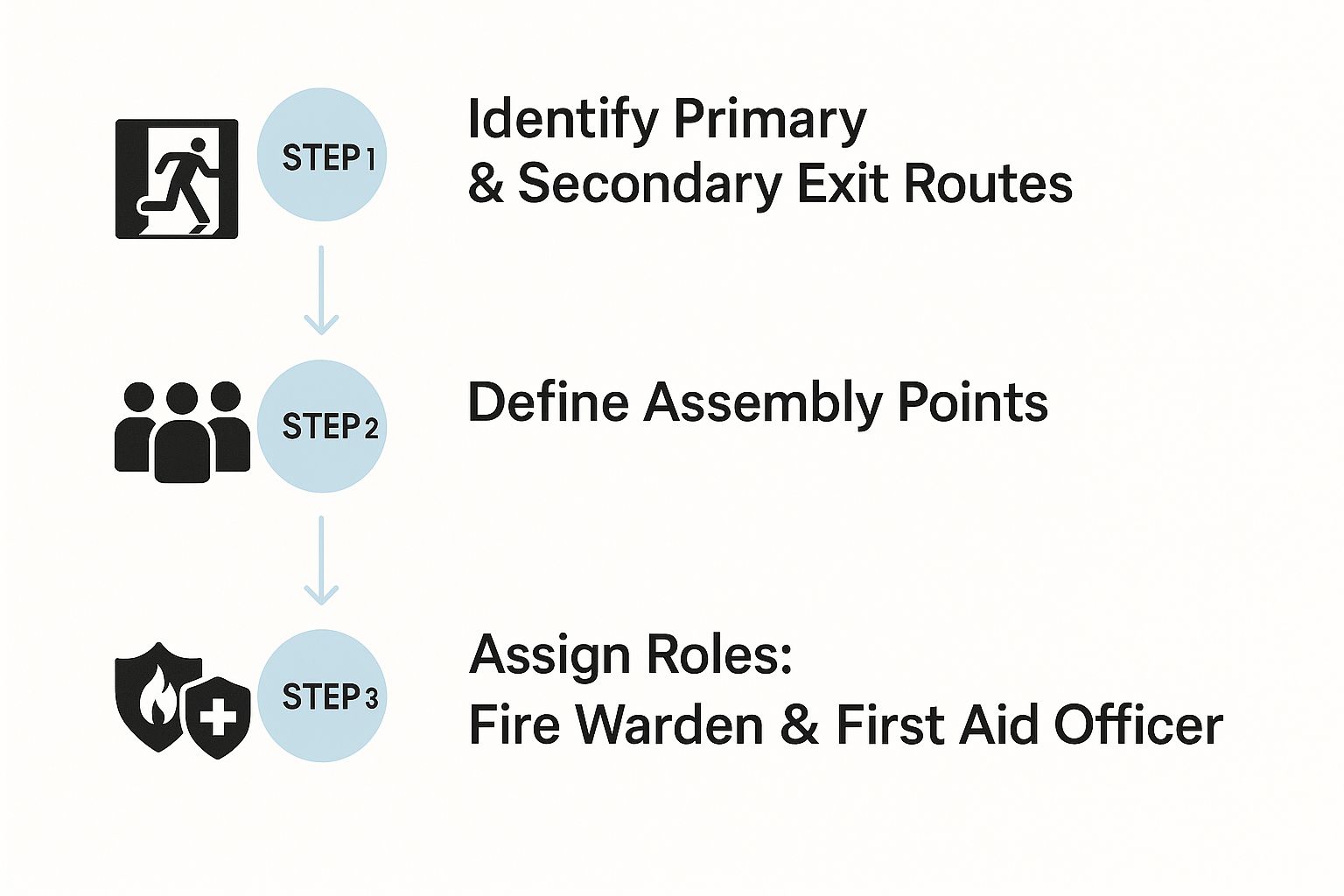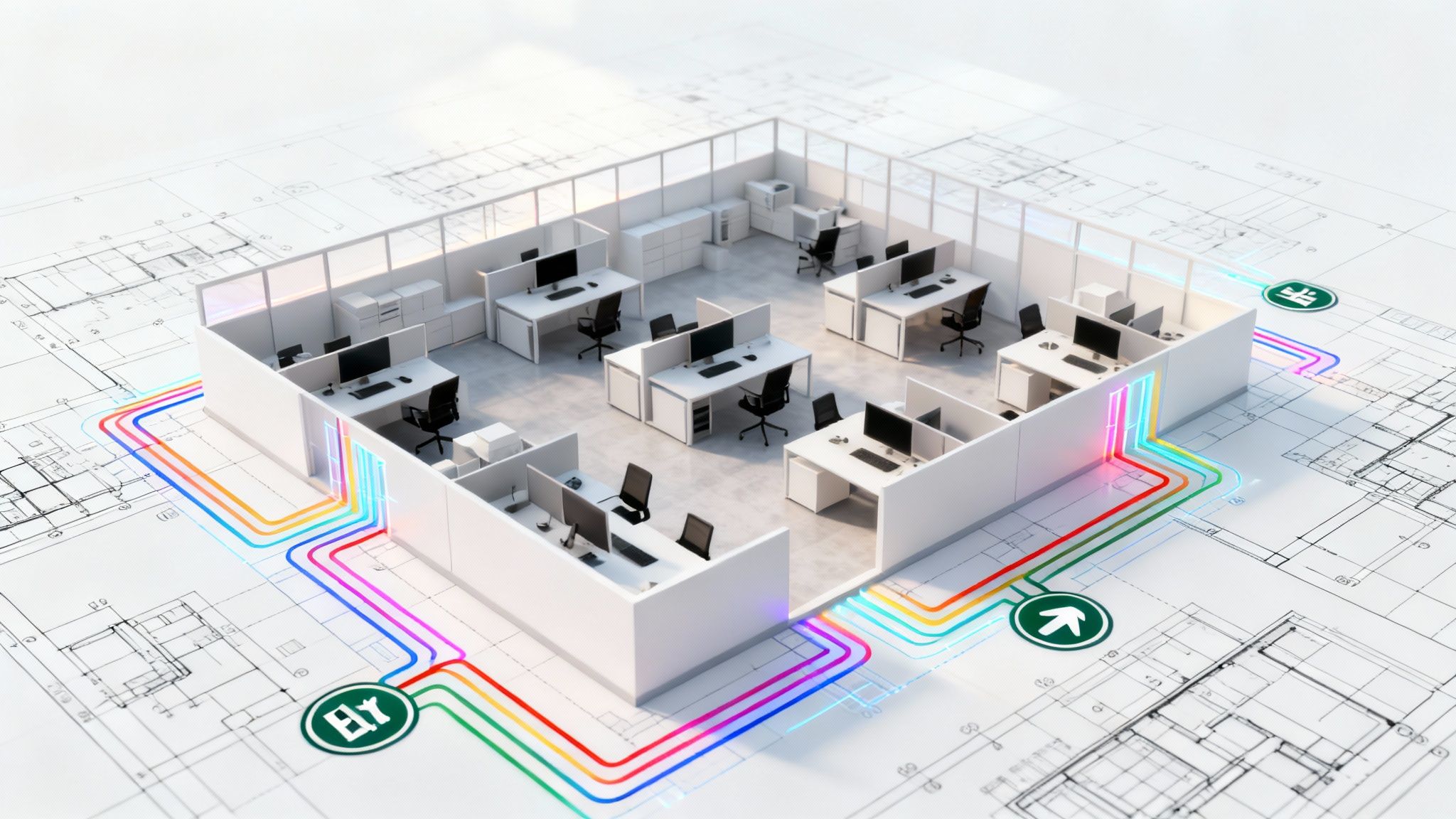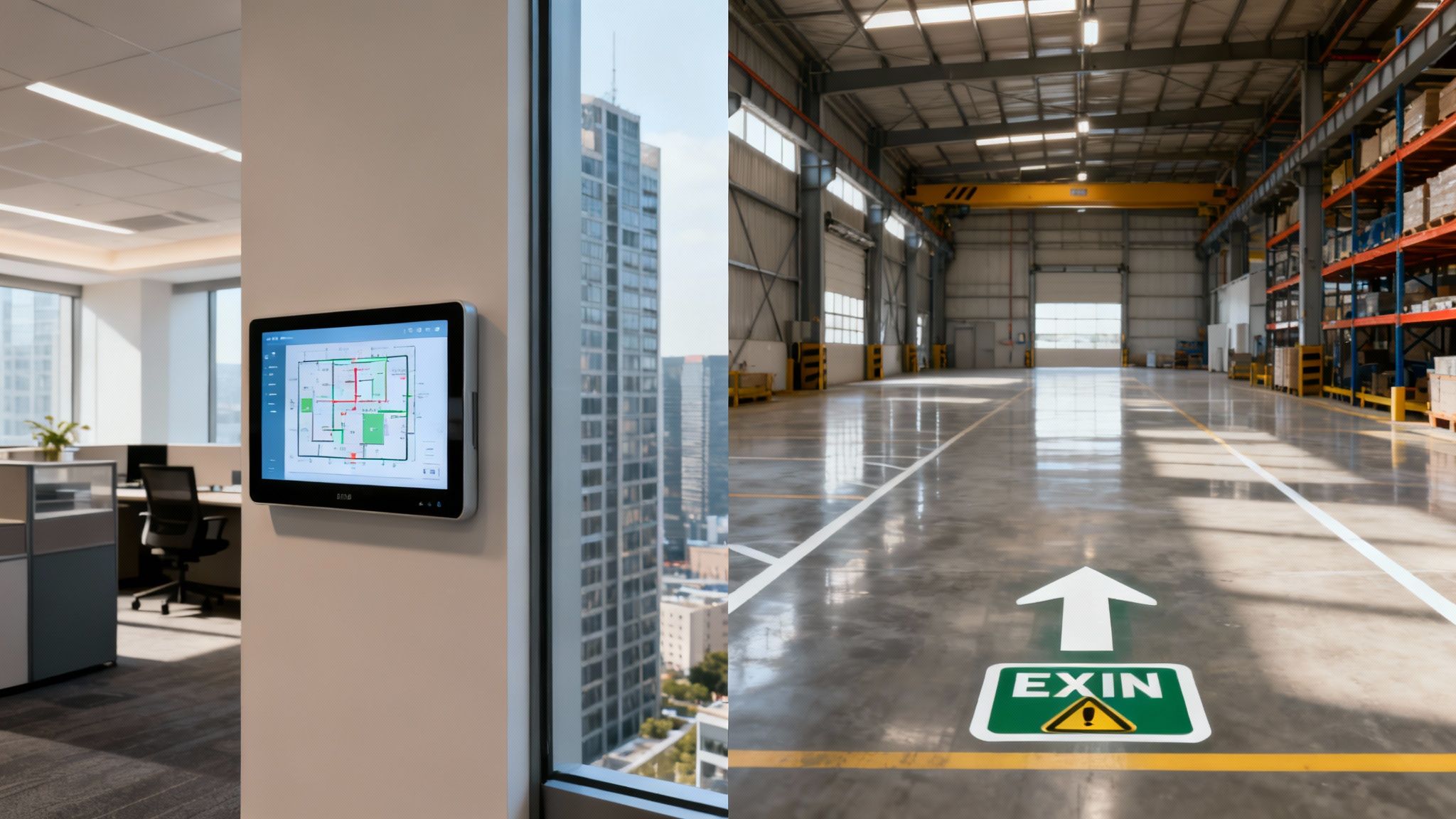
Effective Evacuation Plan Examples for Businesses
A strong evacuation plan example isn't just for compliance—it's a clear, concise guide showing exit routes, assembly points, and communication protocols for an emergency. It's the critical difference between chaos and a controlled process that keeps everyone on-site safe.
Why a Clear Evacuation Plan Is Non-Negotiable

In an emergency, every second is critical. A well-designed evacuation plan is your most important tool for protecting people. The Federal Emergency Management Agency (FEMA) reports that up to 40% of businesses fail to reopen after a major disaster, often due to inadequate preparation. A clear, practiced plan separates a calm, controlled evacuation from a panicked scramble, dramatically reducing risk when it matters most.
Living in Australia, we face constant reminders of why preparedness is essential. Widespread bushfires and floods have taught harsh lessons. For any business, this means having a plan that is not only solid but also flexible enough to adapt to any crisis.
Moving Beyond Compliance to a Culture of Safety
Creating a true safety culture means ensuring every person on your premises—from employees to visitors and contractors—knows precisely what to do in a crisis. This is where modern visitor management tools provide a significant advantage, moving you beyond basic compliance.
A visitor management system enhances your safety protocols by providing an immediate, accurate list of everyone on site. This is vital when the clock is ticking and removes the dangerous guesswork of outdated paper sign-in sheets. The benefits are clear:
- Guaranteed Accountability: With a live roll call accessible from any device, your emergency wardens can instantly verify who is safe at the assembly point and identify anyone who might still be inside.
- Clearer Communication: You can deliver instant alerts and instructions to everyone simultaneously, ensuring consistent messaging during a high-stress event.
- Enhanced Peace of Mind: Knowing you can account for every individual provides confidence that you are meeting your duty of care and protecting your people effectively.
This digital approach ensures your emergency response is driven by precise, real-time data, not by unreliable paper records. Understanding the vital importance of emergency evacuation plans is the first step toward building a genuinely safer workplace.
Lessons from Real-World Events
The difficulty of managing large-scale evacuations is immense. During the 2019-2020 "Black Summer" bushfires, Australian authorities coordinated one of the largest evacuations in the nation's history. A major challenge was the discrepancy between official records and media reports on evacuee numbers.
This experience highlighted a critical need for real-time monitoring to track people's locations during a disaster. These insights are invaluable for businesses looking to strengthen their own emergency strategies and prove the necessity of accurate, live data.
The Core Components of a Successful Evacuation Plan
An effective evacuation plan is a living document that gives clear, simple instructions for getting everyone to safety. For any Australian business, this means breaking down the plan into essential, actionable parts that eliminate guesswork during an emergency.
Every second counts, and research shows that a lack of preparation is a major factor in workplace incidents. A well-rehearsed plan is your best defence against chaos, providing a framework people can follow instinctively when stress is high.
This simple flow chart lays out the foundational steps for building your plan.

It’s a logical progression: map your physical space, define your safe zones, and empower your people. Get these right, and you have the backbone of a solid evacuation strategy.
Defining Your Routes and Roles
First, you must clearly mark all primary and secondary exit routes. This is more than posting signs; it's ensuring these paths are always clear, well-lit, and unobstructed. You must consider what happens if a primary route is blocked by fire—is the secondary route just as viable?
Next is your well-defined assembly point. This must be a safe location, far enough from the building to protect everyone from hazards like fire or falling debris, but close enough to be reached quickly. Every person, from the CEO to a first-time visitor, must know its location.
Equally important is assigning clear roles. Your plan is only as good as the people executing it, so you must designate and train fire wardens and first aid officers.
- Fire Wardens: They guide everyone out, ensuring all areas—including restrooms and quiet offices—are clear before reporting to the emergency coordinator.
- First Aid Officers: They attend to any injuries at the assembly point, providing crucial care until professional help arrives.
Pre-assigning these roles prevents dangerous hesitation and creates an instant command structure when you need it most.
Essential Evacuation Plan Checklist
Here’s a concise rundown of the must-have components for any workplace evacuation plan. Use this table to ensure you've covered all bases.
| Component | Key Action | Why It's Crucial |
|---|---|---|
| Clear Exit Routes | Map and signpost at least two unobstructed exit paths from every area. | Provides alternatives if a primary route is blocked, preventing people from becoming trapped. |
| Designated Assembly Point | Choose a safe, open area away from the building and clearly communicate its location. | A central, safe gathering place is essential for headcounts and prevents further danger. |
| Assigned Roles | Nominate and train fire wardens and first aid officers with specific duties. | Ensures a structured response and avoids confusion during a high-stress event. |
| Visitor & Staff Accountability | Implement a system to accurately track who is on-site at all times. | This is non-negotiable for ensuring everyone is accounted for and for informing emergency services. |
| Emergency Contact List | Maintain an up-to-date list of key contacts, accessible off-site. | Allows for rapid communication with emergency services and key personnel. |
| Regular Drills & Training | Schedule and conduct evacuation drills at least twice a year. | Practice turns theory into instinct, revealing weaknesses in the plan before a real emergency. |
This checklist covers the core pillars of a plan that will actually work when you need it to.
The Critical Role of Accountability
One of the biggest challenges in any evacuation is accounting for every person. How can you be 100% certain that every employee, visitor, and contractor has made it out safely? Traditional paper sign-in sheets fail completely in this regard. In a real emergency, that clipboard is often left behind on the reception desk.
A modern visitor management system transforms this process. It provides a real-time, digital roll call accessible from any phone or tablet. Your fire warden at the assembly point has a live, accurate list for an immediate headcount.
This digital manifest eliminates the frantic search for a paper logbook and gives emergency services a precise list of anyone who might still be inside, saving precious, life-or-death time. It's a fundamental improvement in your ability to protect people. To see how this works in practice, you can learn more about why your business needs an automated evacuation system. This shift from paper to digital is a vital step up in safety.
Crafting Your Custom Evacuation Plan

This is where you move from a generic template to a custom evacuation plan example that fits your workplace perfectly. Every building is different—from sprawling warehouses to multi-storey office blocks—and your plan must reflect your unique layout, risks, and occupants. A one-size-fits-all approach is dangerously inadequate when lives are on the line.
Start with a thorough risk assessment. Walk through your entire site and pinpoint every potential hazard that could force an evacuation. Don’t just stop at obvious threats like fires. Consider chemical spills, security threats, or severe weather warnings. A U.S. Fire Administration report found that cooking fires were the leading cause of nonresidential building fires, showing how even everyday activities can pose a serious risk.
Mapping Your Space and People
Once you understand the risks, map your physical layout. This visual guide is the foundation of your evacuation strategy and must be simple, clear, and easy for anyone to understand in a crisis.
Ensure your map clearly shows:
- Primary and Secondary Exits: Every room or area needs at least two ways out.
- Assembly Points: Logical, safe spots located well away from the building.
- Location of Safety Equipment: Mark every fire extinguisher, first aid kit, and alarm pull station.
- "You Are Here" Markers: To help people orient themselves instantly.
This mapping process forces you to think critically about your space. For businesses in industrial settings, understanding specific industrial emergency evacuation procedures is crucial for creating a robust plan that accounts for complex machinery and hazardous materials.
Choosing Logical Assembly Areas
Selecting the right assembly point is critical. It must be far enough from the building to be safe from fire or structural collapse but close enough to gather quickly. You also need to consider accessibility for people with mobility issues and ensure the location won't block emergency vehicles. For a large site, you might need multiple assembly points for different zones.
The biggest challenge at the assembly point is accountability. A paper sign-in sheet is often left behind, making an accurate headcount impossible.
A visitor management system provides a decisive advantage. It gives your wardens instant access to a live, digital roll call on any mobile device. They can see exactly who was on-site—employees, visitors, and contractors—and tick them off as they arrive.
This empowers your emergency team to act with speed and confidence. They can immediately confirm who is safe and provide emergency services with an accurate list of anyone who might be missing, closing a dangerous gap that many businesses face in a crisis. This level of detailed planning is inspired by large-scale strategies, such as Australia's dual bushfire evacuation strategy, which uses tiered warnings and individual preparedness to manage widespread emergencies. To see more detailed strategies, you can explore other examples of evacuation plans.
Analysing Real-World Evacuation Plan Examples

Theory and templates are a good start, but the true test of an evacuation plan is its application in a specific environment. Let’s break down how a strong evacuation plan example adapts to two different workplaces, each with unique challenges.
Seeing how these plans work in practice highlights why a custom plan is an absolute necessity for keeping people safe. Every detail, from the building's layout to its location, plays a crucial role in shaping an effective emergency response.
High-Rise Corporate Office in the CBD
Picture a busy corporate office on the 25th floor of a CBD high-rise. The building's vertical nature creates immediate challenges. A fire on a lower floor could disable elevators and push smoke into stairwells, making a simple descent a serious physical ordeal.
The plan must be built around:
- Staged Evacuations: It's often safer to first evacuate only the affected floor and those directly above and below to prevent dangerous overcrowding in stairwells.
- Coordination with Building Management: The office's plan must be perfectly synchronized with the emergency systems for the entire building.
- Clear Communication: With potentially thousands of people in the building, calm, clear instructions are essential to prevent panic and ensure an orderly evacuation.
The biggest blind spot here is accountability. How can a warden on the ground floor know if a visitor on the 25th floor has made it out? A paper logbook makes this nearly impossible.
This is where a visitor management system is invaluable. It gives wardens an instant, cloud-based list of everyone on-site. They can access a live manifest on their phone, check off who is safe, and know exactly who might still be inside, regardless of their location.
Industrial Warehouse in a Regional Area
Now, imagine an industrial warehouse in a regional area prone to bushfires. The challenges are completely different. The building is likely a large, single-storey structure, but it may contain flammable materials or heavy machinery that create unique hazards.
The evacuation plan for this site must address:
- External Threats: The trigger might be a bushfire warning, requiring a full site evacuation long before the fire arrives.
- Hazardous Materials: Clear procedures must exist for shutting down equipment and securing dangerous goods to prevent a bad situation from escalating.
- Multiple Assembly Points: On a large site, several assembly points are needed. The correct one will depend on wind direction and the fire's location.
In this scenario, rapid communication is the most critical element. You need to alert every person across a vast, noisy site—from forklift drivers to delivery contractors—simultaneously.
A modern system provides a massive advantage. You can send instant SMS alerts to everyone who has signed in, cutting through the noise and ensuring the evacuation order is received immediately. More importantly, the live digital roll call provides certainty at the assembly point, which is crucial when dealing with a fast-moving threat like a bushfire.
You can explore more detailed strategies by reviewing other examples of evacuation plans that cater to specific high-risk environments.
Bringing Your Evacuation Plan to Life with Training
An evacuation plan is only as good as the team that executes it. A document filed away in a cabinet is useless during a crisis. Its true value is realized through regular training that builds confidence and muscle memory in every person on-site, from permanent staff to temporary visitors.
Effective training ensures everyone understands their role so well that the procedures become second nature. This level of preparedness is crucial not just for internal incidents but also for larger emergencies. For example, during the 2019-2020 bushfires, Australian agencies coordinated huge evacuation efforts, providing over 77,000 meals to evacuees and emergency personnel. This large-scale response highlights how individual workplace plans fit into a broader safety network.
Running Drills That Build Confidence
Regular drills are the most effective way to test your plan and train your people. The goal is to make the process so familiar that staff can act calmly and decisively under pressure. Research consistently shows that a lack of preparation contributes to chaos, making practice non-negotiable.
Here’s how to run effective drills:
- Vary the Scenarios: Don't just run the same fire drill. Simulate other threats like a security alert or a hazardous material spill to test different parts of your plan.
- Block an Exit Route: A primary exit may be unavailable in a real emergency. Forcing teams to use a secondary route during a drill reveals potential bottlenecks.
- Involve Everyone: Ensure drills include all shifts, contractors, and any visitors on-site at the time.
After every drill, gather your wardens and staff for a debrief. Ask what worked well and what was confusing. This direct feedback is invaluable for finding and fixing weaknesses before a real emergency.
A well-structured evacuation training plan is key to ensuring these drills are consistent, productive, and genuinely useful.
Informing Visitors from the Moment They Arrive
A major challenge in any evacuation is ensuring temporary visitors are informed. A modern visitor management system solves this by automatically sharing key safety information during the sign-in process. This simple step ensures that even someone on-site for a quick meeting knows the assembly point location and basic procedures.
To take training even further, especially for emergency scenarios, it's worth exploring new technologies. For instance, you could investigate the practical applications of Augmented Reality for Workplace Safety to create more immersive and effective training experiences.
Answering Your Workplace Evacuation Plan Questions
Even with a strong plan, specific questions often arise. Let's cover some of the most common queries from businesses finalizing their safety procedures.
How Often Should We Actually Run an Evacuation Drill?
Under Australian Work Health and Safety (WHS) regulations, a full evacuation drill is mandatory at least every 12 months. But is that enough? For higher-risk environments like manufacturing plants or facilities with hazardous materials, every six months is a better target. The more you practice, the more automatic the response becomes, ensuring your team can act calmly and efficiently when it matters most.
What’s the Best Way to Account for Visitors?
This is a classic weak point in many evacuation plans. The old paper logbook is almost always left behind, making it useless. The most reliable solution is a digital visitor management system.
This gives your emergency wardens an instant, cloud-accessible list of every person on-site. They can pull it up on their phones at the assembly point to run a live roll call, confirming who's safe and immediately identifying who might still be inside.
What was once a major point of failure becomes a streamlined, life-saving process, providing absolute certainty when you need it most.
Are Digital Evacuation Plans Legally Compliant?
Yes, absolutely. Australian WHS law prioritizes the effectiveness of your safety plan, not its format. A digital plan linked to a modern visitor management system often exceeds minimum compliance standards. It delivers clear advantages that fulfill your duty of care:
- Always Accessible: The plan is available on any authorized device, anytime.
- Instant Updates: Changes to assembly points or wardens can be made and distributed in seconds.
- Superior Accountability: It provides precise tools for communication and critical roll calls.
A solid evacuation plan is the foundation of workplace safety, but its success comes down to execution. VisitUs provides the digital tools to ensure every person on your site can be accounted for in an emergency, giving you the real-time data needed to make life-saving decisions. See how our system can reinforce your safety procedures at https://visit-us.com.





